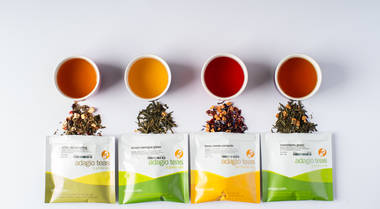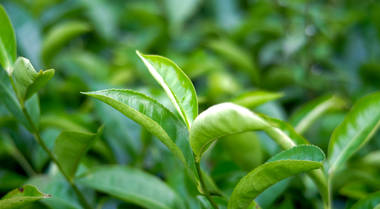Loose Leaf Tea: Black, Green, Herbal Tisanes, and more
September 17, 2025

What's the Difference Between Herbal Tea and Real Tea?
When most people say "tea," they could mean just about anything. A steaming mug of chamomile, a brisk cup of English Breakfast, or even a fruity hibiscus iced drink may come to mind. But here's the thing: not everything we call "tea" actually comes from the tea plant. Some infusions are "real" tea, while others fall into the category of herbal tea (also known as tisanes).If you've ever wondered why some teas wake you up with caffeine while others help you wind down, the answer lies in what you're brewing. Let's break down the differences between herbal teas and true teas, and help you decide which might be the best fit for your day.
What Counts as "Real Tea"?
When we talk about "real tea," we're referring to beverages made from the leaves of one plant: Camellia sinensis. It doesn't matter if you're sipping a grassy Japanese green, a delicate white tea, or a robust black blend, because they all come from this single species.What makes them different is how they're processed:
• Green tea (like our Sleeping Dragon) is quickly heated after harvest to preserve its fresh, vegetal character.
• Black tea (such as Earl Grey Bravo or Ceylon Sonata) is fully oxidized, bringing out bold, malty, sometimes citrusy notes.
• Oolong tea (for example, Fujian Rain) sits somewhere between green and black, with layers of complexity that can taste floral, fruity, or creamy.
• White tea (like Silver Needle) is the least processed, prized for its gentle sweetness.
• Pu-erh tea (Our Pu-erh Poe) undergoes fermentation, developing earthy, rich flavors.
All true teas contain varying amounts of caffeine, natural antioxidants, and flavor compounds shaped by their origin and style. This is why a morning cup of black tea might get you going, while an afternoon green feels lighter and more refreshing.
Herbal Teas: Flavorful, Caffeine-Free Alternatives
Now let's look at the other side of the coin: herbal teas. Unlike real tea, these blends don't come from Camellia sinensis. Instead, they're made from herbs, flowers, fruits, roots, or spices steeped in hot water. The result is a colorful category with almost endless variety.Some popular herbal options include:
• Chamomile: Known for its soft, apple-like flavor and calming qualities.
• Peppermint: Refreshing, cooling, and often enjoyed after meals.
• Hibiscus: Bright red, tart, and fruity, perfect for iced blends.
• Rooibos: A naturally sweet, earthy infusion from South Africa, often paired with vanilla or fruit.
• Lavender: Floral and aromatic, often blended with lemon or mint.
There's a wide range of herbal blends available, from single-ingredient classics like Chamomile and Peppermint to vibrant mixes like Spiced Blood Orange, which combines hibiscus with warm spices and citrus for a tangy, refreshing cup.
Herbal teas are naturally caffeine-free, making them a great choice for evening sipping, children, or anyone who wants to enjoy the ritual of tea without the buzz.
Key Differences Between Herbal and True Teas
So how exactly do herbal teas and true teas compare? Let's break it down.• Plant Origin: True tea comes from Camellia sinensis. Herbal tea can come from almost anything else! Things like mint, chamomile, fruit, spices, even blends of multiple ingredients.
• Caffeine Content: Real teas naturally contain caffeine, though amounts vary by type and brewing method. Herbal teas are almost always caffeine-free (with the exception of yerba mate, guayusa, and yaupon).
• Flavor Profiles: True teas have a spectrum from grassy and floral to malty and smoky, depending on style. Herbal teas cover a broader range, from sweet and fruity to spicy and savory.
• Tradition: True teas have deep roots in cultural traditions across China, Japan, India, and beyond. Herbal teas often stem from folk medicine or local culinary customs.
• When to Drink: Real teas are often chosen for focus and alertness. Herbal teas shine as a calming nightcap or a hydrating, flavorful alternative throughout the day.
One area in which they do overlap, though? They both invite creativity! You can blend real tea with herbs (think jasmine green or chai spice black) for the best of both worlds.

Why the Confusion?
If herbal teas aren't technically "tea," why do we call them that? The answer is partly history, partly habit.The word "tea" originally referred to beverages made with Camellia sinensis. But as trade spread and people discovered new plants to steep, "tea" became shorthand for any hot, flavored infusion. The French term "tisane" is more accurate for herbals, but in English, "herbal tea" stuck, and the name never really left.
So when someone asks for "red tea," they might mean rooibos, hibiscus, or even a darker black tea. Context is everything, and most people don't stress about the technical definition once their mug is in hand, of course.
How to Choose What's Right for You
Choosing between herbal tea and real tea depends on what you need in the moment.• Reach for real tea when you want a gentle caffeine boost, a focus aid for studying or working, or when you want to savor the nuanced flavors of classic teas. A morning English Breakfast, a noontime Dragonwell, or an oolong with dinner can all be perfect.
• Go herbal when you want something caffeine-free, whether it's chamomile before bed, peppermint after a heavy meal, or a fruity iced hibiscus on a hot day.
You don't have to pick just one, either. Many blends combine the two, like rooibos chai or green tea with fruit. Experimenting with both categories can add variety to your tea routine and make every cup feel new.
Tea Is What You Make It
At the end of the day, whether you're brewing up true tea leaves or a soothing herbal blend, what matters most is your preference and what you're in the mood for. Tea is about flavor and taking a pause in your day. It doesn't have to be about strict definitions.So next time you're browsing for a blend, think less about whether it's "real" tea or "herbal tea," and more about what you're craving. Bright and energizing? Go for green or black. Cozy and calming? Try chamomile or rooibos. Either way, you'll find something to enjoy. You might even discover a new favorite along the way!